
From TACSAT to JUMPSEAT: Hughes and the top secret Gyrostat satellite gambleby Dwayne A. Day and Nicholas W. Watkins
|
| “Ultimately, we had to decide which program to go after because we did not have the resources to compete vigorously for both,” Iorillo wrote. “Having recently failed to beat TRW for both Intelsat III and a classified program for the National Reconnaissance Office (NRO), we needed a win.” |
By the late 1960s, the Space Systems Division of Hughes Aircraft Company was already a dominant force in satellite communications, having developed the first geosynchronous orbit communications satellite, Syncom 2 in 1963, and its commercial successor, Intelsat I, better known as Early Bird, in 1965. In early 1969, another new Hughes technology, the Gyrostat, made its space debut. This time it was on the tactical communications satellite, or TACSAT, one of the first geostationary military comsats. The Gyrostat was a damping system which prevented satellites from inevitably spinning around their longest axis. By allowing “long and thin” satellites, the Gyrostat maximized the use of shroud space on the Titan IIIC launcher, enabling TACSAT to be nearly eight meters long and three meters in diameter. TACSAT was a spinning cylinder with a large antenna “farm” on its top, and at over half a ton in mass, and with over 200 watts of power to the UHF antenna array, it has long been known to be a pioneer and record-breaker among comsats. Newly revealed information is, however, only now showing how TACSAT gave Hughes the knowledge and skills to successfully compete for several other key military and intelligence satellite contracts over the next few years, including the JUMPSEAT signals intelligence (SIGINT) and Satellite Data System (SDS) data-relay satellites. The new information also confirms the long-rumored dual role of JUMPSEAT in carrying both signals intelligence (SIGINT) and infrared missile detection payloads, though some puzzles remain.
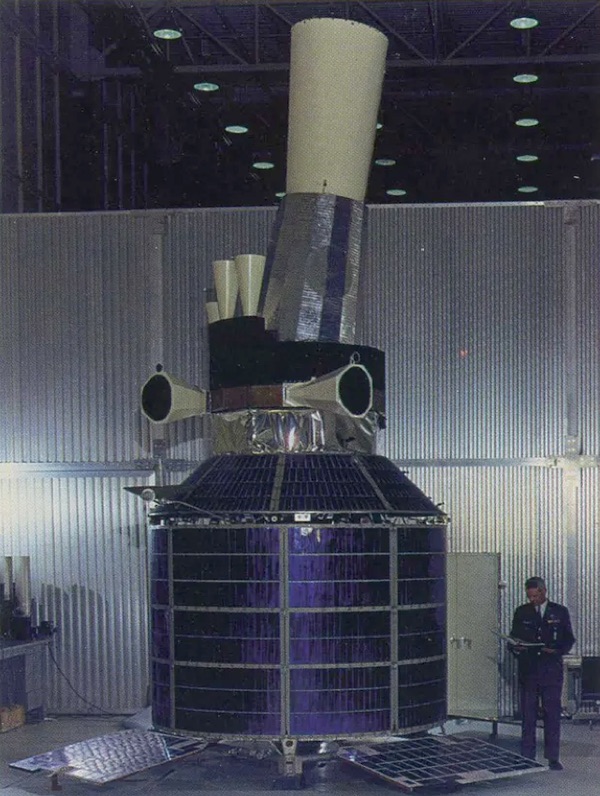 TRW’s Defense Support Program satellite had a design whereby the entire spacecraft spun, with the infrared telescope pointed toward the Earth. This satellite could not easily be adapted to other missions, unlike Hughes’ Gyrostat design. (credit: USAF) |
In 1966, the US Air Force’s Space and Missile Systems Organization, known as SAMSO, put out notice that it was interested in purchasing two new satellite programs. One was for a new missile warning satellite that would carry a large infrared telescope, and scan the Earth from geosynchronous orbit, looking for the heat signatures of Soviet ICBMs. The other was for a large communications satellite which as Aviation Week put it “would determine whether hundreds of small, mobile terminals with varying power levels can effectively use a single satellite without the formal network discipline now employed in satellite communications between large ground terminals.”
According to Tony Iorillo, inventor of the Gyrostat, who was then a spacecraft dynamics specialist at Hughes, its Space Systems Division marketing team “followed the development of TACSAT specs very carefully.” Hughes had also been one of several companies funded during 1965 to study a new missile warning satellite, which would later become known by the rather bland term the “Defense Support Program” (DSP) and at this time was known as Program 949.
“Ultimately, we had to decide which program to go after because we did not have the resources to compete vigorously for both,” Iorillo wrote in a recent online newsletter for Hughes Space Division alumni. “Having recently failed to beat TRW for both Intelsat III and a classified program for the National Reconnaissance Office (NRO), we needed a win.”
| Hughes officials were also probably aware of a new classified satellite program for the NRO that would soon be competed, and its marketing people determined that by winning TACSAT, Hughes would be well-positioned to win the other contract as well. |
The classified program that Hughes had just lost was most probably the geostationary RHYOLITE signals intelligence satellite, known since the Boyce and Lee spying case of the late 1970s to have been built by TRW. One other high-altitude classified communications intelligence satellite was also already in development at this time, and known as CANYON, but it was built by Lockheed. The first CANYON was launched into geosynchronous orbit in August 1968. (See “Applied witchcraft: American communications intelligence satellites during the 1960s,” The Space Review, October 19, 2020.)
Both the DSP and TACSAT programs were for the US Air Force. According to Iorillo, “Paul Visher, our assistant division manager and Bud Franklin, our manager of Advanced Projects, chose TACSAT as the target.” The reason was that top Hughes Aircraft officials, including its vice president and general manager, Lawrence A. “Pat” Hyland, “believed that the TACSAT satellite configuration was more representative of future program targets than the peculiar DSP configuration.”
Hughes was not a bidder in the last round for the DSP contract, which was between Lockheed (possibly teamed with Baird Atomic) with an evolved geostationary version of their Agena-based MIDAS in which the telescope would have its own spin platform, and the winners TRW (teamed with Aerojet) with their proposed spinning satellite. The sensor and spacecraft contracts, to Aerojet and TRW respectively, were awarded in the winter of 1966–67.
Iorillo’s reference to “the peculiar DSP configuration” is evident in photographs of the early DSP satellites. The large infrared telescope pointed at a slight angle to the satellite’s cylindrical body, and spun with it, at a relatively slow 6 rpm compared to TACSAT’s 50 or so. That design was not adaptable to other missions, whereas the Gyrostat allowed a large antenna farm to be mounted on a platform that was de-spun from the spinning cylinder, and pointed sideways, at an approximately 90-degree angle. This latter configuration meant that various antennas could be mounted on a platform while the main part of the satellite, the “bus”, housing the power system and stabilization and other systems, could potentially remain essentially the same for different missions, or conversely be scaled up or down as needed. The TACSAT bus was designated HS-308.
Hughes officials were also probably aware of a new classified satellite program for the NRO that would soon be competed, and its marketing people determined that by winning TACSAT, Hughes would be well-positioned to win the other contract as well, by adapting the unique Gyrostat approach to the new mission. “In 1967 and 1968, even before TACSAT was launched, we used the TACSAT win as our relevant related experience” to win the classified satellite contract, which Hughes designated the HS-318, and that for Intelsat IV, which used the HS-312 variant, Iorillo explained. As early as the the winter of 1966, Hughes had already built an air-bearing-supported demonstration model of a complex Gyrostat-based satellite, one indication of its importance to the company. In an August 1967 paper written by Iorillo for the Dual-Spin Satellite Symposium at Aerospace Corp., one of a collection of his papers declassified in 2019 by the NRO, it was noted that “for missions with large power requirements, oriented panels… may be required. The system would then be a multi-spin configuration with a rotor, and Earth-oriented platform, and a sun-oriented platform” corresponding well to the configuration depicted by the model and in an artist’s impression on the collection’s cover page.
“With a large satellite configuration in hand, we beat TRW, and others, for the HS-318 and Intelsat IV contracts. These wins came just in time to prevent having to lay off the Surveyor and Intelsat II teams whose programs were ending. Even TACSAT was to end in a year. Thanks to Mr. Hyland’s foresight and faith, the bulk of these people were carried for many months entirely on company funding,” Iorillo noted.
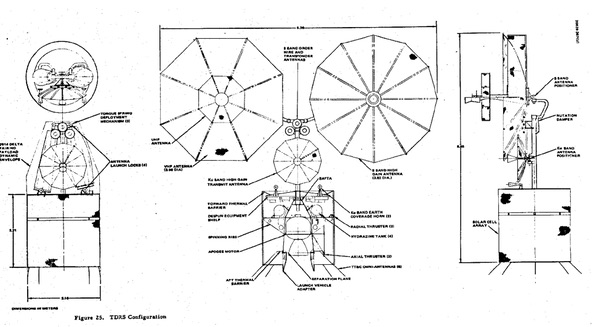 Drawings of a 1972 Hughes Tracking and Data Relay design study for NASA. GEO spacecraft is sized for a Delta 2914 launcher. The two largest antennae are each 3.82 meters diameter. This proposal was derived from the earlier designs for TACSAT and Intelsat IV. (credit: NASA) 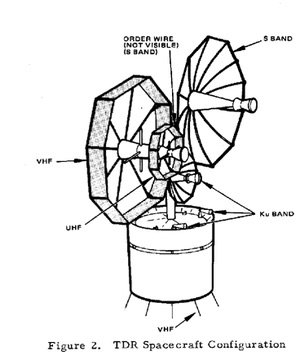 |
The NRO contract for HS-318 was apparently awarded in 1967. Probably not by coincidence, 1967 was also the year of peak debate over the capabilities of Soviet anti-ballistic missiles (ABM), and in particular, a system that the US intelligence community referred to as “TALLINN,” after the location in Estonia where what was suspected to be a new ABM system had first been detected (see “An enigma behind the curtain: the Tallinn anti-ballistic missile system and satellite intelligence”, The Space Review, March 18, 2019). “TALLINN” became shorthand for any similar system spotted elsewhere in the USSR. Coming after the initial Moscow ABM system, TALLINN led some members of the US military to argue that the Soviet Union had a rapidly expanding plan for an ABM system, and the United States needed one as well, while others, especially the CIA, saw TALLINN as essentially a defense against high altitude aircraft. As early as November 1965, a draft memo from Robert MacNamara, recorded in the Foreign Relations of the United States document series, reported to LBJ that “the evidence suggests this [i.e. TALLINN] may not be an effective ABM defense, though this conclusion is by no means certain.”
President Johnson’s frustration with this controversy drove a demand for better intelligence collection about the capabilities of Soviet ABM radars and missiles. (See “Big bird, little bird: chasing Soviet anti-ballistic missile radars in the 1960s,” The Space Review, December 14, 2020.) In summer 1967, Alexander Flax, the Director of the National Reconnaissance Office, described both “lower-cost” and “higher-cost” options for meeting this demand. The NRO soon added new payloads for detecting ABM radar signals to existing satellites, and began building additional small satellites apparently equipped for conducting specialized intelligence collection against the ABM radar signals that were detected—apparently the “lower-cost” option. This increased emphasis on ABM intelligence collection also apparently led to the development of an entirely new class of signals intelligence satellite known as JUMPSEAT—Flax’s “higher-cost” option, which was most likely the HS-318 satellite that Hughes started to develop in 1967.
| JUMPSEAT may have originated as a higher-altitude replacement for STRAWMAN, with a payload for detecting the elusive ABM radar signals. But their second payload makes these satellites even more intriguing. |
Iorillo wrote, “After we won TACSAT, I worked on both the HS-318 ‘green’ program and Intelsat IV proposals.” Green was the color of the badges worn by people working on this classified program, whereas the badges for another project, SDS, were yellow. “Bill Bakemeyer was the ‘green’ proposal manager and Al Owens was the Intelsat IV proposal manager. I was in charge of the Technical Volumes and Executive Summaries for both. The proposals were sequential, with brief overlaps, so that I could do both. I used many of the same staff. For example, Al Wittman was the principal design integration leader for both.”
Iorillo also provided a bit more detail on the JUMPSEAT satellite they had to develop. “The ‘green’ program was much more demanding. It was our first entry into the operational world of satellite reconnaissance. And it was not a geostationary orbit mission. The satellite was a multi-mission vehicle carrying an electro-optical precision pointed payload and a very wide band ELINT [electronic intelligence] payload with large steerable receive and downlink antennas. We also designed and built the elaborate ground data processing segments for both payloads along with the satellite command and control station. The Surveyor guys were perfect for the job.”
SIGINT is the overall term for the collection of electronic transmissions. SIGINT also includes electronic intelligence (ELINT), which usually means the collection of radar signals; and communications intelligence, or COMINT. At that time, the NRO operated large SIGINT satellites in low Earth orbit as part of Program 770. By the latter 1960s, a series of Program 770 satellites known as MULTIGROUP was being replaced by a new series named STRAWMAN, equipped with multiple antennas, including some focused on detecting anti-ballistic missile radars. Operating in low Earth orbit, the STRAWMAN satellites did not spend much time over Soviet territory. JUMPSEAT may have originated as a higher-altitude replacement for STRAWMAN, with a payload for detecting the elusive ABM radar signals. But their second payload makes these satellites even more intriguing.
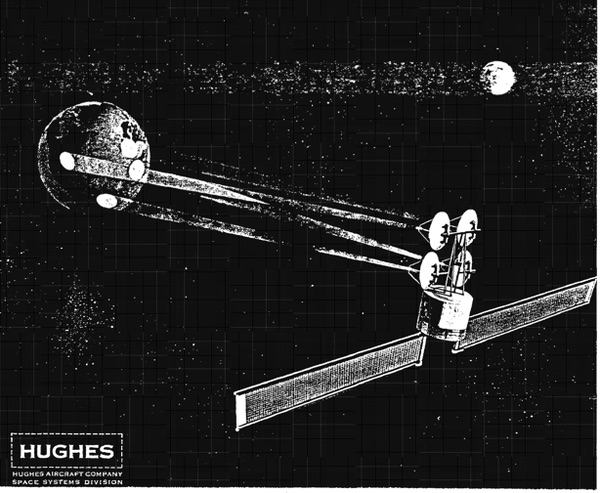 Photo of air-supported demonstration model with its designer Tony Iorillo, and the cover of a recently declassified Hughes report. (credit: NRO and Hughes alumni Our Space Heritage website) 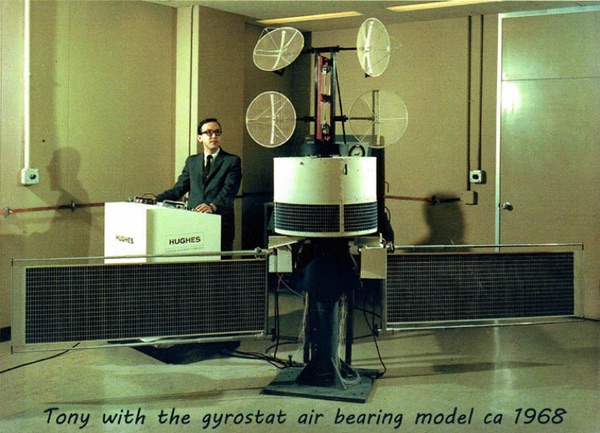 |
About the same time that TRW was beginning work on the newly-awarded DSP infrared early warning satellite for SAMSO, and Hughes was successfully bidding for the HS-318 signals intelligence payload for the NRO, another infrared sensor mission was gaining support in the US Air Force, which may help explain JUMPSEAT’s enigmatic dual payload. Despite its classified nature, the new mission appears to have started out in the same organization, SAMSO, that created the Program 949 (DSP), not in the much more secretive NRO. In March 1967, the Air Force’s senior leadership presented the results of a study concerning the ability of an infrared sensor operating in the range of 2.68 to 2.97 microns in either medium altitude or geosynchronous orbit to detect ICBMs and short-burn missiles such as ABMs. The sensor would need to have a much higher scanning rate than the Program 949 satellite. This higher scanning rate was necessary to detect the ABMs before their engines burned out. As a bonus, the higher scanning rate would also enable the sensor to detect reentry events, such as Soviet warheads during ICBM tests. According to a memorandum summarizing the briefing from the USAF assistant secretary for R&D (and also director of the NRO) Al Flax to the Secretary of the Air Force, Harold Brown, this would be an intelligence sensor, not one intended to directly support Air Force operations like the Program 949/DSP satellites.
| There is new evidence that even before Hughes’ HS-318 satellite began flying, the company was trying to capitalize on its experience with TACSAT to expand its military business and win back a contract that their rival TRW had previously won. |
Because Aerojet had their hands full with the DSP sensor, the Air Force determined that these other sensors could best be built by Hughes, and that a Lockheed satellite then being built “for another program” could host them. The goal then was to have a spacecraft available in 15–18 months, presumably because of the urgency that then surrounded the resolution of the ABM controversies. But events seem to have taken a different course, and rather than riding on a Lockheed satellite in 1968, an intelligence infrared sensor may instead have found its way to an elliptical orbit on Hughes’ first HS-318 satellite, three or so years later. It may be that the unique ability of the Gyrostat to at the same time host and point both a despun SIGINT antenna array and a fast-spinning infrared sensor platform allowed the merging of two roles from the outset, perhaps acknowledged in the otherwise cryptic name of JUMPSEAT—a name for an extra seat in an airplane cockpit or cabin for use by trainee, pilots, off-duty crew, and other staff who are not flying the plane. In any event it seems clear that combining infrared and signals intelligence from the same vantage point during any ABM test would help to reduce the contentious ambiguities, especially if it was an end-to end test that exercised both the missile and the ABM radars. In his history of this era, Chris Manteuffel noted that “generally, satellites could record radar signals, and they could take pictures of the radar antenna, but they could only rarely capture enough of a signal to understand the full capabilities of a system. Even as late as the mid-1970s, the US had no records of the radar signals for a Tallinn System missile engagement; they had records of the radar tracking targets, but the only evidence of what a launch would be like was based on photographs.”
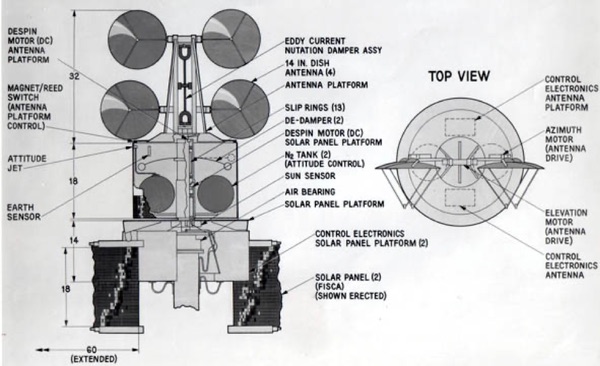 Drawing of the Hughes Gyrostat demonstration model. (credit: Hughes alumni Our Space Heritage website) |
Iorillo does not say so, but it remains possible that an infrared payload was not included in the first HS-318 satellites but added later. There is new evidence that even before Hughes’ HS-318 satellite began flying, the company was trying to capitalize on its experience with TACSAT to expand its military business and win back a contract that their rival TRW had previously won. In June 1969, Paul Visher of Hughes visited the NRO’s headquarters to discuss Hughes’ proposal for a follow-on version of the Program 949 missile warning satellite based on the Gyrostat newly demonstrated by TACSAT. It was a time of great pressure on the military and intelligence budgets, and only a few days before the cancellation of the Manned Orbiting Laboratory, which was a major blow to the space intelligence industry.
The evolution of TRW’s as-yet-unflown DSP was troubled: it was experiencing cost overruns, Aerojet’s telescope would eventually be delivered late, and ITT’s subsidiary optical sensor had already been cancelled completely. According to NRO Director John McLucas’ short writeup of the meeting, using his Air Force letterhead and not his NRO one as Flax had also done in 1967, Visher proposed that two of the missile warning satellites could be placed in an “elliptic orbit, each collecting information and transmitting it directly to a station in the United States.” This would remove the long-term need for the DSP ground station at Nurrungar, Australia, construction of which began in November 1969. According to an interview with Flax by the late Jeffrey Richelson for his 1999 book on DSP, along with correspondence with the late Ellis Lapin of Aerospace, an elliptical orbit option, which brought with it the cheaper Titan IIIB-class rocket, had been seriously considered for DSP, but cost considerations had still favored a single GEO satellite and a foreign ground station.
Visher also shared another proposal which ostensibly would not have required an overseas ground station: two satellites in geosynchronous orbit, one carrying the infrared sensor and the other configured as a data relay satellite capable of relaying information from the sensor satellite as well as other satellites. McLucas noted that the two satellites in elliptic orbits would be cheaper because they would be identical, whereas the other option involved two different spacecraft.
Visher’s proposal to the NRO is fascinating because it described both an elliptical (non-geosynchronous) satellite with a missile warning sensor, and a geostationary data relay satellite. The NRO did indeed field satellites of both these types, albeit in different contexts to those of Visher’s pitch. Although it was not done as an operational follow-on to the Program 949/DSP satellites, the NRO did procure JUMPSEAT, which Richelson reported was indeed a signals intelligence satellite that at some point was equipped with an infrared missile detection payload apparently named HERITAGE, just as Iorillo has described the HS-318 satellite as “carrying an electro-optical precision pointed payload and a very wide band ELINT payload.” Whether the satellite program begun in 1967 included the infrared payload from the start, or added it at some point after the first few satellites, is not yet known. What is known is that Iorillo’s paper at the summer 1967 Aerospace Symposium depicted a Titan III-launched spacecraft as one of two Gyrostat reference missions studied, and that this satellite has a lower device which appears cylindrical and resembles a telescope, though apparently smaller than the three-meter design carried on DSP and probably only illustrative of the capability to mount equipment below the main satellite structure. The same study describes calibration of “optical payload (including many IR devices)” (not simply horizon sensors, which are discussed separately) on stars, as opposed to the calibration of radio frequency payloads using known ground-based transmitters.
It thus seems likely that while Visher was proposing to steal the DSP contract away from TRW, in June 1969 he already had good reason to believe that Hughes’ satellite could support an infrared sensor in an elliptical orbit, because his company was building JUMPSEAT with just such a payload. Ultimately, though, TRW won the delayed contract for the second batch of Program 949/DSP satellites, and they were broadly similar to the first generation.
| Whatever the precise motivation for its design, however, even as JUMPSEAT was under development, the flux of new information about the Moscow ABM and TALLINN surface-to-air missile systems began to change the requirements for overhead signals intelligence collection. |
Due to continued classification of the high-altitude signals intelligence satellites, it is impossible to determine the sequence of events or final decisions. It remains possible that the HS-318 satellite started out solely as a signals intelligence satellite for NRO purposes and then, after Hughes demonstrated that it could also carry an infrared sensor, that capability was added to the satellite, either during development or after several satellites had launched.
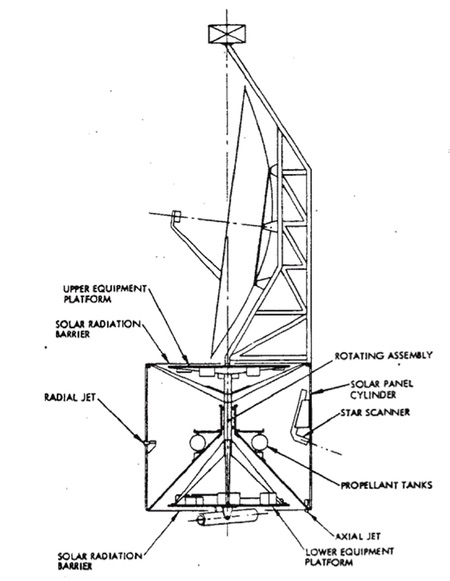 “Typical Titan-Class Gyrostat Configuration” from 1967. This is not stated to be a GEO mission, unlike the reference configuration sized for an Atlas-Agena in the same paper. Note the cylindrical device mounted underneath the main satellite bus, indicating that the design could have been adapted for JUMPSEAT. (credit: NRO) |
Whatever the precise motivation for its design, however, even as JUMPSEAT was under development, the flux of new information about the Moscow ABM and TALLINN surface-to-air missile systems began to change the requirements for overhead signals intelligence collection. In a National Security Council meeting on June 30, 1971, recorded in the Foreign Relations of the United States series of reports, President Nixon expressed the view that “the public relations problem is serious but my understanding is that we don’t give much of a damn about their ABM capability.” By 1972, with the signing of the anti-ballistic missile treaty, the ABM threat was diminished in importance as both sides were limited in the number of their ABM sites, meaning that US intelligence satellites were now required for treaty monitoring rather than ferreting out entirely new weapon systems. If not already doing so, JUMPSEAT satellites could then have assumed other signals intelligence roles.
Meanwhile, as Jeffrey Richelson recounted in 1999, the HERITAGE infrared sensor’s role acquired the name “DSP-Augmentation” and was now supposed to provide both intelligence data about short-burn missiles and operational missile warning data. The two missions were not easily reconcilable, because intelligence data could be analyzed over time, whereas operational missile warning data had to be acted upon immediately. Although it shared a ground station with DSP at Buckley Air National Guard Base (now Buckley Air Force Base) in Colorado, Richelson reported that DSP-A remained a bit of a contentious issue with some in the military and intelligence communities. In the early 1990s, Space News reported that the HERITAGE sensor was still flying and that Lockheed and Hughes had teamed to offer it in competitions for the convoluted process which eventually produced a replacement for DSP. Hughes reportedly took its sensor with it when it paired instead with TRW for the SBIRS program competition, only to find itself the losing bidder.
The first JUMPSEAT satellite was launched in March 1971 aboard a Titan 34B-Agena D rocket. The satellite entered an unusual orbit for an American spacecraft, the Molniya-type used by the eponymous Soviet comsat series, both highly elliptical and highly-inclined to the Equator. This orbit meant that it spent most of its orbit flying over the northern hemisphere where it could look down on the Soviet landmass. A year before, Aviation Week had already revealed its Air Force code number, 711, its launcher, its elliptical orbit, its contractor, and its SIGINT mission to “monitor foreign radar activity” (the name JUMPSEAT was not revealed until the late 1980s, in Seymour Hersh’s book about the shooting down of Korean Airlines flight KAL 007 by a Soviet fighter plane in 1981.) In June 1976, the NRO launched the first SDS data relay satellite, which operated in a similar orbit. Much later, in the 1990s, some versions of SDS added a geostationary capability, and in its turn DSP had earlier been given a dual orbit capacity allowing use of the elliptical Molniya type, although this has never been used. Meanwhile the first Intelsat IV commercial communications satellite launched in January 1971. Hughes was on its way both to dominating the commercial comsat industry for the next two decades, and having a strong foothold in providing high-altitude intelligence satellites to the NRO.
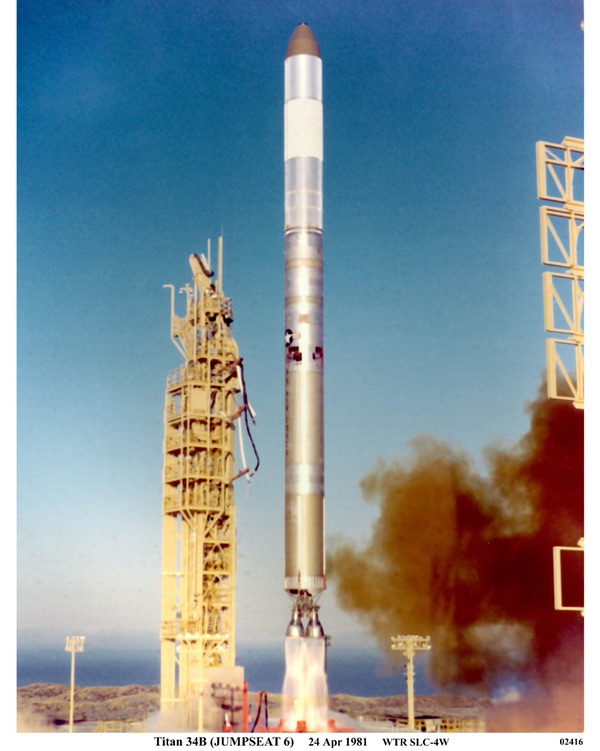 Titan 34B launch on April 24, 1981, from Vandenberg AFB of what is believed to be JUMPSEAT 6. (credit: Peter Hunter Collection) |
Note: we are temporarily moderating all comments submitted to deal with a surge in spam.